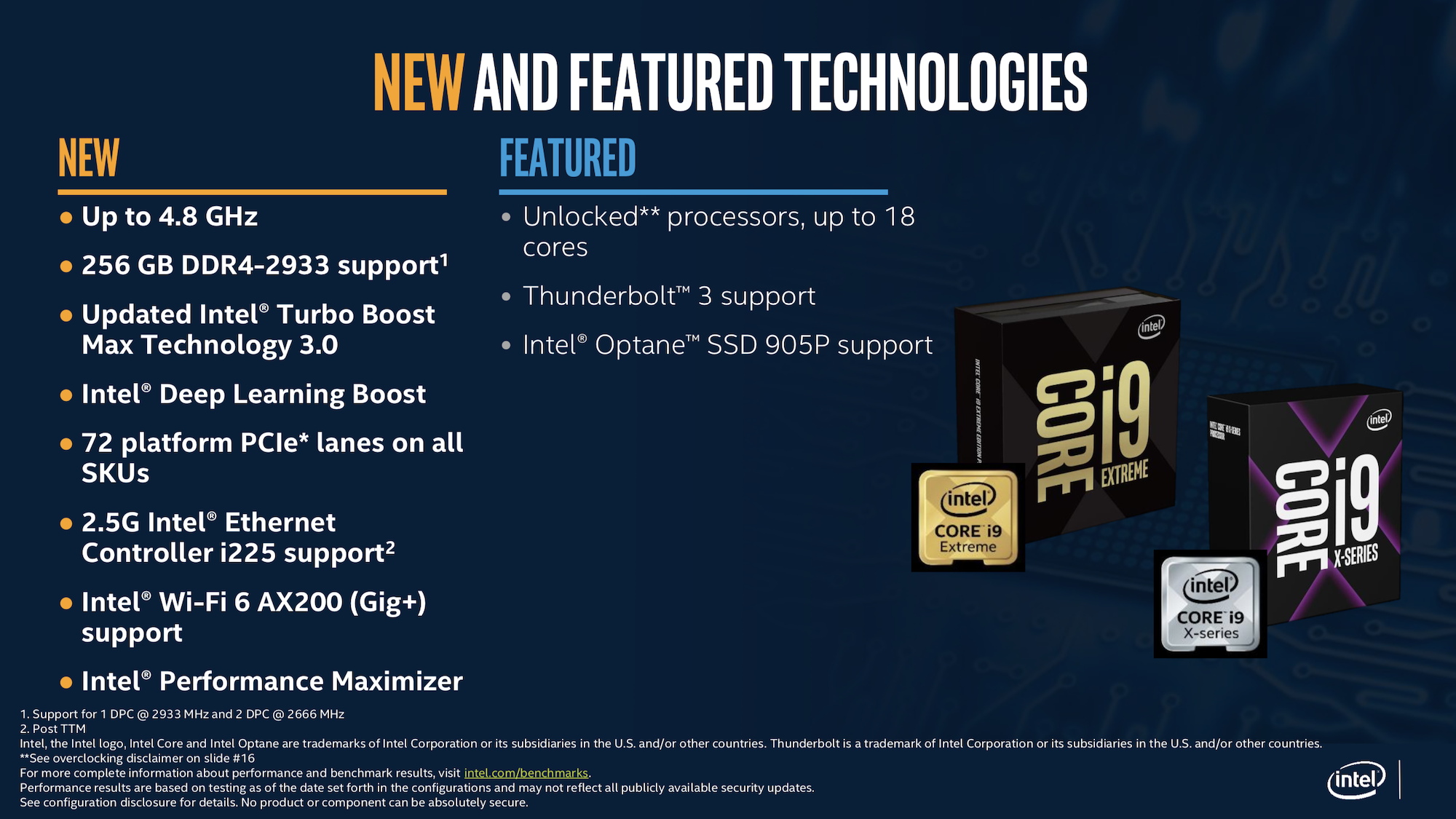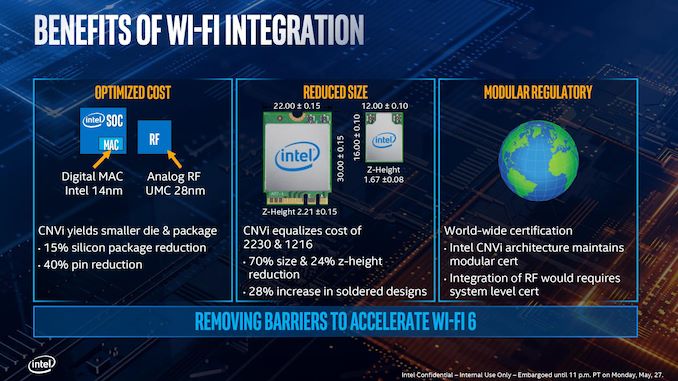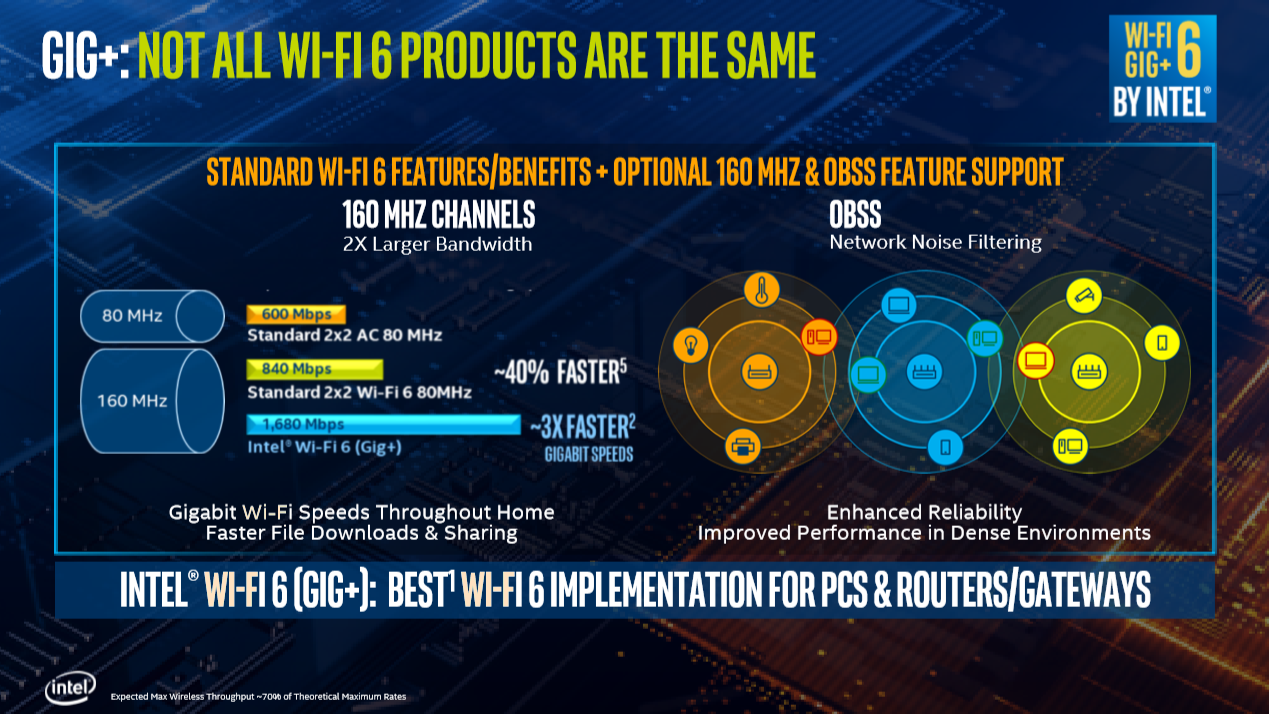Intel Brings Wi-Fi 6 and 2.5GbE to the Desktop With Cascade Lake-X
Intel is bringing 2.5GbE and Wi-Fi 6 to the desktop.
As Intel disclosed during its Cascade Lake-X launch, the company is bringing new networking tech to the desktop with its i225-V controller for 2.5Gbps Ethernet, while its AX200 module slots in for Wi-Fi 6 wireless connectivity. Coincidentally, those are two technologies that chief competitor AMD does not have as in-house IP, adding to Intel’s value proposition.
2.5Gbps Ethernet Appears
After over a decade of 1 Gbps Ethernet, Intel is now moving to a 2.5GbE PHY with its i225-V Ethernet controller, codenamed Foxville. Phoronix was first to discover Foxville in 2018 via Linux kernel patches, and the chip is now expected to be integrated into new LGA2066 motherboards for the recently announced Cascade Lake-X high-end desktop (HEDT) processors.
While HEDT is a very small portion of the market, TechPowerUp expects the chips will also find their way to the 400-series chipsets that Intel will launch with the upcoming 10th-Gen Comet Lake-S desktop processors.

Realtek, Broadcom, and multi-gigabit Ethernet leader Aquantia have already launched their 2.5GbE PHYs, so Intel isn’t the only brand with 2.5GbE PHY by any means. However, Intel's move to this faster generation is likely to speed up the mainstream adoption, including potentially more mainstream multi-gigabit switches.
TechPowerUp claims that Intel is the most popular GbE provider with its i218-V and i219-V controllers, and explains that Intel’s Ethernet controllers have a low cost due to their reliance on PCH-based MAC and a proprietary PCIe-based bus, strengthening their appeal:
“Much like the i219-V, the i225-V is a low-cost PHY that relies on PCH-based Ethernet MAC and its proprietary PCIe-based bus that runs at half the data-rate of PCIe. This is precisely why the i219-V doesn't feature on AMD motherboards, but rather its pricier sibling, the i211-AT, which comes with an integrated MAC and a standard PCIe interface.”
Intel’s product page states that the controller has a 1.95W TDP and a $2.40 recommended customer pricing (RCP). The enterprise remains at 10GbE.
Get Tom's Hardware's best news and in-depth reviews, straight to your inbox.
Wi-Fi 6 Boosts Wireless Connectivity
Cascade Lake-X will also support Wi-Fi 6, previously known as 802.11ax.
Wi-Fi 6 is expected to enjoy rapid adoption, with an over 50% adoption rate in end-devices by 2022. It delivers a theoretical bandwidth of up to 2.4Gb/s. Cascade Lake-X’s support follows in the footsteps of the mobile 10th-Gen processors. However, support is different for the two platforms.

On the mobile side, Intel first partially integrated Wi-Fi functionality with its 8th-Gen lineup. Intel infuses the digital logic of its Wi-Fi 5 directly onto the chipset, called integrated connectivity or CNVi. Customers can then buy a separate M.2 form factor or soldered companion module (CRF) for the RF components of the solution. The two solutions connect through a proprietary CNVio interface. This gives Intel a cost advantage over third-parties because the chipset contains the CNVi regardless of whether one uses the CRF or a third-party Wi-Fi 6 solution with a PCIe link. Put another way, the only companion RF modules come from Intel.
With its 10th-Gen CPUs, Intel has now done the same for Wi-Fi 6 by integrating it into the 400-series mobile chipset. Intel claims the RF module package is 70% smaller than the fully discrete solution, and the combined silicon area is 15% smaller. Intel doesn’t integrate the RF component because that would require Wi-Fi certification at the system level instead of the module, which would be a headache for partners. It also allows Intel to build the RF analog component on UMC’s 28nm process.
Wi-Fi 6 support on Cascade Lake-X, on the other hand, merely means the platform supports Intel’s discrete PCIe-based AX200 adapter. It has an RCP of $10.00-17.00. For comparison, the aforementioned AX201 companion RF module costs $9.00-$16.00. Intel’s most advanced discrete Wi-Fi 5 product, Wireless-AC 9260, has a bandwidth of 1.73Gb/s for $9.00-15.00.
Wi-Fi: Technical
Wi-Fi 6 has two new key features. 802.11ax makes use of what is called quadrature amplitude modulation (QAM). In telecommunications, periodic electromagnetic waves are used to transmit data. The waves represent data by varying the parameters of the wave, such as its phase, amplitude, or frequency. This is called modulation. Now, if one would alter several of these characteristics, or for example, use multiple phases, then it would be possible to represent multiple bits within a signal.
This is similar to multi-level cell NAND. For example, the latest quad-level cell (QLC) NAND uses sixteen voltage levels to represent 4 bits in one cell. This would be the equivalent of 16-QAM. Just like in NAND, though, transmitting more bits per symbol comes at the expense of a higher signal-to-noise ratio (SNR).
As the first new feature, Wi-Fi 6 now uses 1024-QAM instead of 256-QAM. So this means that there are now 10 bits per symbol instead of 8, yielding a 25% improvement in bandwidth.
The new OFDMA feature helps with data and time scheduling. Simply put, data packets can now have varying sizes and multiple streams simultaneously, where each stream represents a different application, such as video streaming, gaming, etc. These resources units, as they are called, are centrally scheduled to avoid contention overhead. The benefit of this feature is reduced latency and greater efficiency in dense deployments. Intel reported a reduction in latency from 36ms to 7.6ms.

Intel claims that its own Wi-Fi 6 implementation, which it calls Gig+, is the best. Intel's implementation also supports optional 160MHz channel binding, instead of 80MHz, and network noise filtering. The latter provides better reliability and improved performance in dense environments.
Summing up, Wi-Fi 6 delivers 75% lower latency, 4x more network capacity, which translates to 4x throughput in congested areas, and 39% higher nominal bandwidth. Intel’s Wi-Fi 6 also supports the optional 160MHz channel binding for another 2x improvement in bandwidth, bringing the expected bandwidth increase to 2.8x. (A 160MHz channel is also optional in Wi-Fi 5.) Intel’s graph shows the expected throughput at 70% of the theoretical maximum speed.